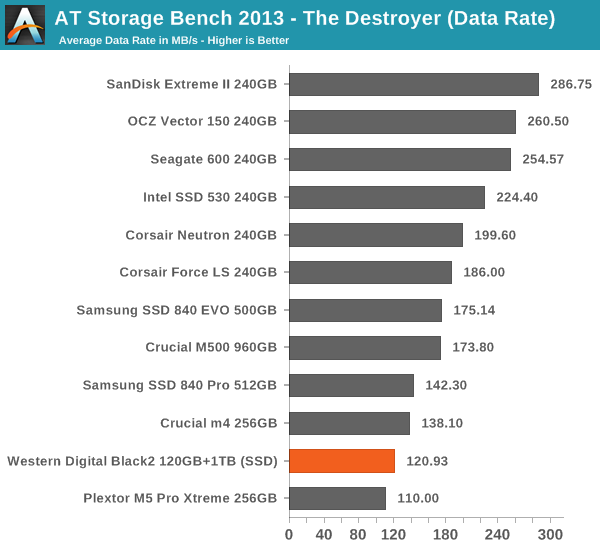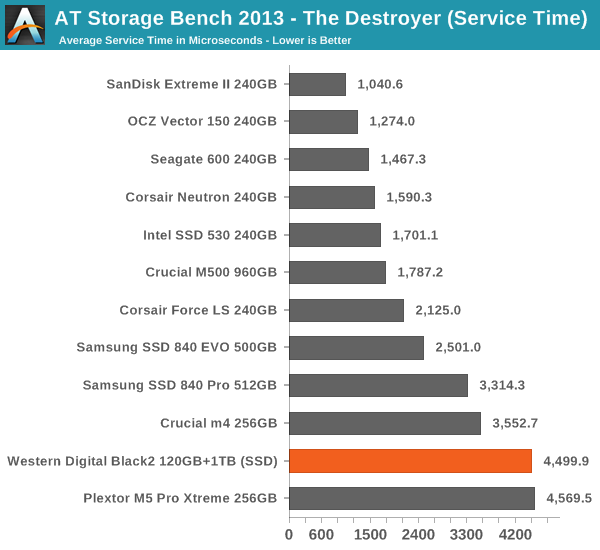The WD Black2 Review: World's First 2.5" Dual-Drive
by Kristian Vättö on January 30, 2014 7:00 AM ESTAnandTech Storage Bench 2013
Our Storage Bench 2013 focuses on worst-case multitasking and IO consistency. Similar to our earlier Storage Benches, the test is still application trace based -- we record all IO requests made to a test system and play them back on the drive we're testing and run statistical analysis on the drive's responses. There are 49.8 million IO operations in total with 1583.0GB of reads and 875.6GB of writes.
As some of you have asked, I'm not including the full description of the test for better readability, so make sure to read our Storage Bench 2013 introduction for the full details.
| AnandTech Storage Bench 2013 - The Destroyer | ||||||||||||
| Workload | Description | Applications Used | ||||||||||
| Photo Sync/Editing | Import images, edit, export | Adobe Photoshop CS6, Adobe Lightroom 4, Dropbox | ||||||||||
| Gaming | Download/install games, play games | Steam, Deus Ex, Skyrim, Starcraft 2, BioShock Infinite | ||||||||||
| Virtualization | Run/manage VM, use general apps inside VM | VirtualBox | ||||||||||
| General Productivity | Browse the web, manage local email, copy files, encrypt/decrypt files, backup system, download content, virus/malware scan | Chrome, IE10, Outlook, Windows 8, AxCrypt, uTorrent, AdAware | ||||||||||
| Video Playback | Copy and watch movies | Windows 8 | ||||||||||
| Application Development | Compile projects, check out code, download code samples | Visual Studio 2012 | ||||||||||
We are reporting two primary metrics with the Destroyer: average data rate in MB/s and average service time in microseconds. The former gives you an idea of the throughput of the drive during the time that it was running the Destroyer workload. This can be a very good indication of overall performance. What average data rate doesn't do a good job of is taking into account response time of very bursty (read: high queue depth) IO. By reporting average service time we heavily weigh latency for queued IOs. You'll note that this is a metric we've been reporting in our enterprise benchmarks for a while now. With the client tests maturing, the time was right for a little convergence.

Our Storage Bench 2013 favors 480GB and bigger drives due to its focus on steady-state performance. Having more NAND helps with worst case performance as ultimately steady-state performance is dictated by the speed of the read-modify-write cycle, which depends on the program and erase times of the NAND. The more NAND the drive has, the higher the probability that there is at least some empty blocks available.
When taking the lower capacity into account, the Black2 isn't terrible but it's not great either. There are some 256GB drives that perform similarly, although it should be noted that the Black2 has 12% over-provisioning instead of 7%, giving it a slight advantage there (the drives are filled with sequential data before the test after all).











100 Comments
View All Comments
Kristian Vättö - Thursday, January 30, 2014 - link
There is no official Mac support, so maybe. I just tried using the drive in OS X and added my findings but unfortunately I don't have the tools to properly test it in a Mac.Maltz - Thursday, January 30, 2014 - link
To create a Fusion drive, you have to have two separate devices, not partitions. This drive shows up as a single device.name99 - Friday, January 31, 2014 - link
I don't think that's true. diskutil (in the command line) is crazy tolerant of gluing all sorts of weird shit together. The GUI is much more strict.What you MIGHT have to do if first run
diskutil ar create concat ...
to convert each partition to an AR2 partition. You can then run diskutil cs to fuse these partitions together. As a general principle, whenever diskutil refuses to do something with a raw partition, wrapping it in an AR2 partition will get the job done.
Calinou__ - Thursday, January 30, 2014 - link
This drive is the first Windrive.Panzerknacker - Thursday, January 30, 2014 - link
Very smart and interesting how they designed this. Considering the separation between SSD and HDD happens on LBA level and is based on the partition table, I don't understand why a driver is required though. This should work out of the box. Could you test this a bit more?Xajel - Thursday, January 30, 2014 - link
As they stated, it's a limitation of the SATA protocol, SATA is a point-to-point protocol, means you can't connect more than one device to the same SATA port... there's an un-required extension to the SATA protocol which is called SATA multiplier, basically it's a chip in the other hand of the SATA cable ( of course not in the cable it self ) that will take a single SATA cable and connect it to multiple drives... though it's not available in all chipsets as it's not required...I still hope WD will come with another version with such support, or who knows, maybe a small switch to select between which mode you want, but that will require more space for such switching... but my main concern with these approaches is when one of the drives fails ( after warranty goes )... you will loose a hell !!
In the mean while, I feel the best solution is to find a laptop with both mSATA and 2.5" SATA so you will not worry about one of the drives failing and you loose both...
Panzerknacker - Thursday, January 30, 2014 - link
No this is not true. As they stated, separation between the SSD and HDD happens INSIDE the drive, by means of a system which sends I/0 targeted at the first 120gb of the drive's sectors to the SSD, and I/0 targeted at the rest of the sectors to the HDD. The system in which the Black 2 is installed should see only one 1120GB disk with 2 partitions (default). I don't understand why this would require a driver because the system does NOT know or need to know what's going on inside the drive as long as you don't mess with the default partition layout.DanNeely - Thursday, January 30, 2014 - link
The 2 partitions in one drive thing only happens after the drivers are installed. It's implemented using port multiplication which means that it has 2 different drives hanging off a single sata port. Some older computers didn't come with support for it, so WD used the looks like only a 120GB drive by default kludge for wider spread compatibility.While I understand the need for back compatibility, and wouldn't have a problem if they defaulted to legacy support; I do wish they provided an option either in a configuration app or via a jumper selection that would let it expose itself as a pair of port multiplied drives for systems that do support the feature without having to go through WDs indirection layer.
extide - Thursday, January 30, 2014 - link
Yeah but thats not the case. Panzerknacker is right. If it truly was port multiplication then the computer would see two individual drives. Instead it sees one big one. Theoretically it should be able to work without a driver and show up as a single drive, its kinda like a JBOD of the SSD + HDD built into the drive. That shouldn't need any drivers.Also, is there linux support for this?
Kristian Vättö - Thursday, January 30, 2014 - link
Not officially but once the partitions have been set in Windows they show up fine in Linux and OS X.